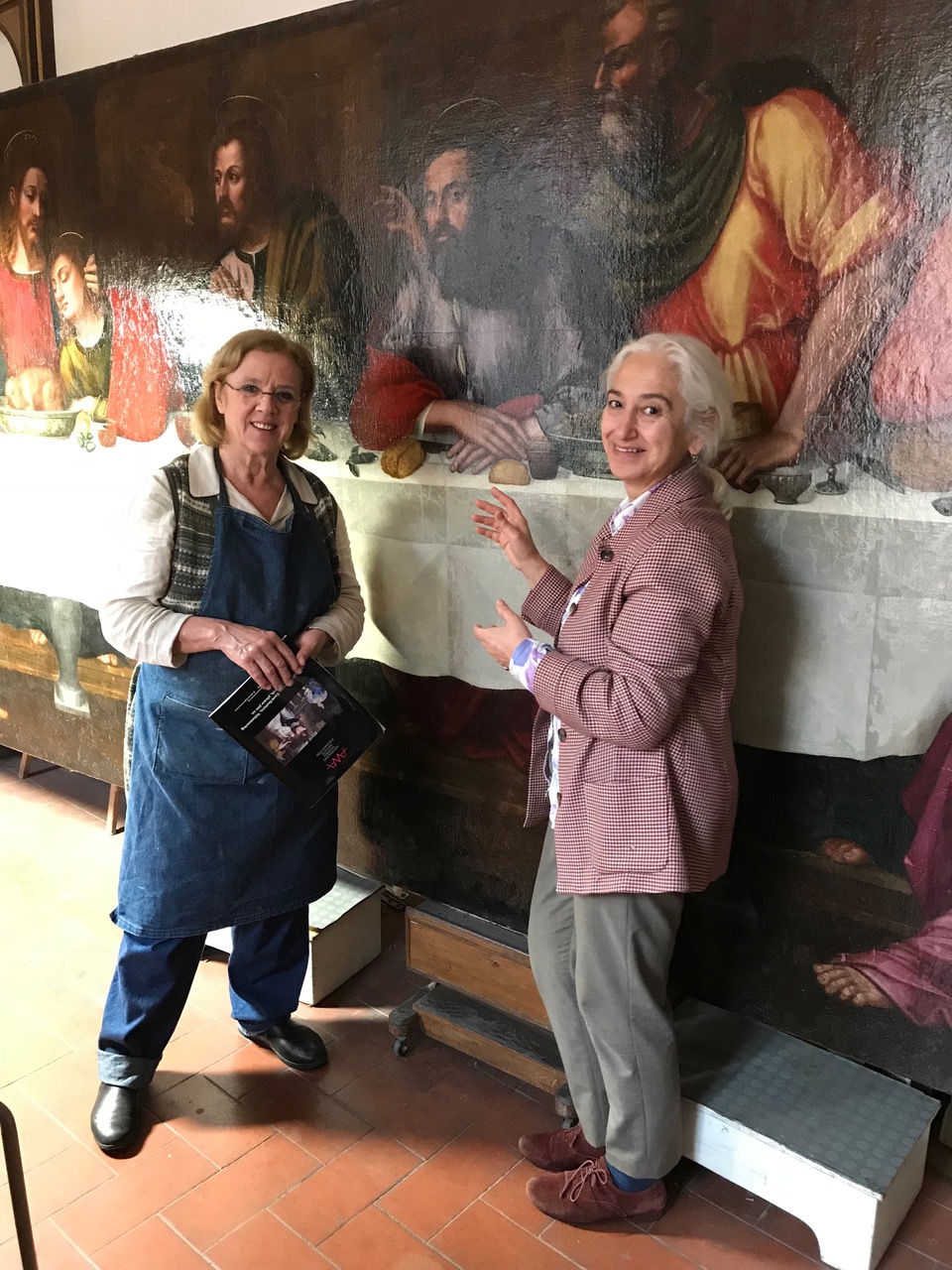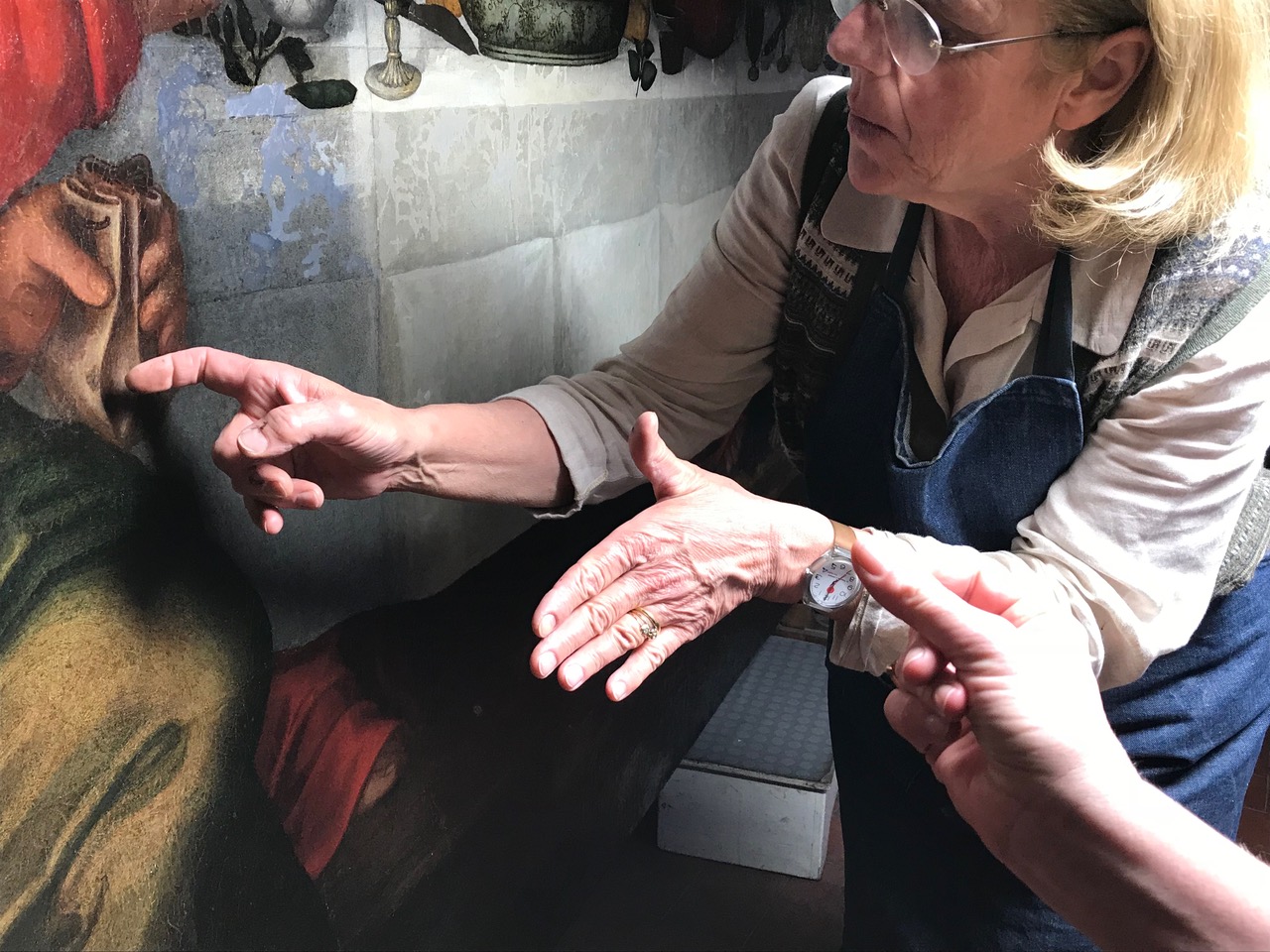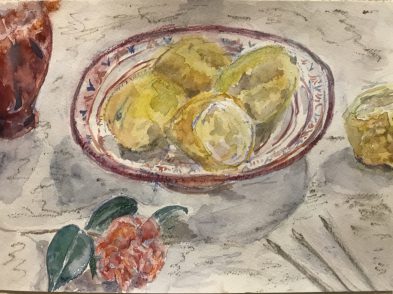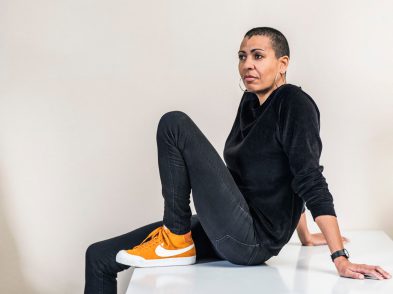What would it mean to “adopt an Apostle”, to participate in the restoration of a damaged and forgotten masterpiece so that it will be possible for our contemporaries and also future generations to be captivated and moved by it as I was a few weeks ago on my visit to the restorer’s studio? To know that you are helping to bring to future generations the work of an artist working 500 years ago and almost to literally get under the skin of the painting and thereby, metaphorically, under the artist’s skin? As a painter myself, my visit to a restorer’s studio to view and discuss the ongoing restoration of a Last Supper by the artist and nun gave fascinating insights.

Art restorer Rossella Lari with Rea Stavropoulos in front of Nelli’s Last Supper. Photo: Jane Adams for AWA
Advancing Women Artists (AWA), for over 10 years, has been at the forefront in helping to ensure that the women artists of Florence are recognised and receive their just place in both the history of the city and the history of art in its widest sense. In pursuit of this goal and headed by its founder Jane Fortune, they have searched for, discovered and identified important works that have been neglected, damaged and in need of restoration, and/or not on public view. They have raised funds to restore these works, employing some of the highly experienced women restorers in Florence. They have documented the restoration projects through books and DVDs as well as producing important publications that catalogue the work of women artists in the museums, galleries, churches and monasteries of Florence. This work has led to the city of Florence’s highest honour being given to AWA’s founder and The Florentine’s culture editor Jane Fortune, who was given the Fiorino d’Oro, the golden florin, by Mayor Dario Nardella at a ceremony in the Palazzo Vecchio’s Salone del Cinquecento.
AWA has gone from strength to strength and its latest project, the restoration of Suor Plautilla Nelli’s 21-foot Last Supper is its most ambitious yet. Imagine, a woman, a nun, encumbered by the clothes that would have protected her modesty working on something on this scale, both in terms of its physical size and the ambition, confidence and skill that it required. As an artist who has worked on some large-scale works (though in no way as ambitious as Nelli’s), I know how physically demanding this can be, but I live in an era and a society where women exercise, are more active and able to move unrestricted by superfluous clothing. I think beyond the masterpiece and about the woman who challenged herself with such a project whilst living in a cloistered community.
My visit to the studio of Rossella Lari, the restorer who is single-handedly restoring Nelli’s Last Supper was a moving experience. Rarely does a member of the public have the privilege to examine a painting so closely, but also to see it through layers of its history and to discuss the incidental discoveries that Lari has made through the meticulous process of cleaning centuries of dirt to reveal the artist’s original intention and to make decisions regarding the “touching up” or repainting, which are both discreet but which also have to intuit that intention. Our conversation moved to materials and I was touched to discover that Rossella, like me when I paint in watercolour, uses Winsor and Newton Series 7 sable brushes, considered to be the finest! But I was amazed to learn that the sizes she uses for this restoration project are numbers 2 and 3, among the tiniest there are, so that each intervention she makes barely touches the surface of the painting. To work on a painting of this scale with such tiny brushstrokes is a gargantuan task and I am full of admiration for her patience and dedication.

Hands. Photo: Jane Adams for AWA
Looking closely at the painting, I was struck by subtle details and relationships between objects that created timeless small tableaux in themselves, on the table a glass goblet of red wine, the surface of the wine gleaming in the light and the area of tablecloth viewed through the glass, subtly different in tone from the adjoining cloth, the creases from its careful unfolding showing at regular intervals, a beautifully tooled bowl of salt, a porcelain tureen with lettuce pile high, all beautiful still lives. Caravaggio is said to have remarked that painting still life requires as much artistry as painting figures, and one can see this in Nelli’s oeuvre.
But where her work moves me the most is in her painting of hands. Perhaps as a painter, I am particularly aware of hands as it is through these members that we transmit the energy that wields the brush, that combines both control of the paint flow and sensitivity to what is rendered. But beyond that, hands can portray the character, personality and mood of the sitter even more than a face, and looking at Nelli’s Apostles I am struck by all these factors. There is an individual approach and tenderness in the rendering of each hand, which I find incredibly moving. Reading the painting through the drama created by the hand movements is like a subtext to the whole. Can one tell an artist’s gender from her work? I don’t know. I would rather judge an artist on the strength of her work and its power to touch the viewer’s emotions and intellect. But there is a particular combination of grace, strength and tenderness in Nelli’s portrayal of hands in this painting that attests to her distinct personality and greatness as an artist.







